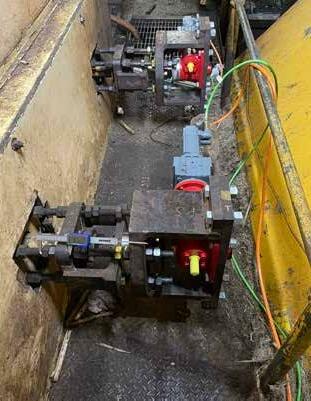
4 minute read
AUTOMATED STRATEGIES TO EFFECTIVELY PROCESS EXISTING SOFT CANE VARIETIES
AUTOMATED STRATEGIES
TO EFFECTIVELY PROCESS EXISTING SOFT CANE VARIETIES
Advertisement
Researchers are working to establish improved automated strategies for processing existing soft sugarcane varieties, some of which can cause processing problems in the factory.
Main issues experienced have been feeding of the cane through the milling train and high bagasse moisture contents, which cause subsequent combustion issues and low steam pressure at the boiler station. The goal is to achieve high throughput and extraction at the mill, as well as low final bagasse moisture.
The research has been coordinated over the last three years by Geoff Kent and Floren Plaza (Queensland University of Technology), Kelly Ryan and Phil Woods (Isis Central Sugar Mill) and Roy Parfitt (Sugar Research Australia).
Work began with pilot scale shredder tests in 2019, followed by full-scale milling trials in 2020, and the installation of additional automated strategies in the Isis milling train in 2021.
The project, funded by Sugar Research Australia, has reached the final stage: carrying out automated trials in the 2022 crushing season.
QUT researcher Geoff Kent said shredder speed and grid-bar adjustment, along with the added water rate were the preferred adjustments, depending on where in the milling train the processing difficulties occurred.
“What we're doing now is adding those things into an automatic control system. That's what's new,” he said.
The project builds on many previous studies that measured the impact of adjustments across several mill parameters, and importantly, document the performance using the factory’s online process control system.
Geoff said it was important to reduce the preparation of soft cane and reduce the amount of water added onto the extraction process.
“If you want a mill to perform well, you need to load it up so that it
achieves a set torque.” Geoff Kent
“What we're aiming for is to get to that torque value. When we process soft canes, the torque drops. The torque is telling us when a cane is soft enough that we need to do something.”
Researchers have observed different reactions across the first and second mill at Isis, applying a torque control system on each mill.
“When the torque drops off on the first mill, we either slow down the shredder or we increase the setting on the grid. And similarly on the second mill, if the torque starts to get close to the point where it’s going to be lost, we can reduce the added water rate with the intent that the torque will come back up again.
“When you lose the torque, the moisture goes up. Low torque means high moisture, and moisture means problems with the boilers because you can’t generate steam.” Geoff said the team had also applied a new approach in automating the grid setting on the shredder.
“The shredder is a hammer mill, so you have this rotor that rotates very quickly. It's got a lot of hammers on it. The hammers bash the cane and turn it into straw, breaking a large proportion of the cells and making the sugar juice available for easy extraction.
“After that initial hit, the cane has to work its way through the shredder to get out and we have what we call a grid towards the exit of the shredder, which is a series of spaced bars.
“The cane has to come past those bars. There are very small gaps between the tip of the hammers and bars, while there are gaps between the bars. The resultant flow forces the straw into and out of the gaps.
"The cane straw slows down, then ends up back in the path of the hammers and is impacted repeatedly by the hammers. This increases the number of broken cells in the straw. The gap between the hammers and the bars, and therefore the final preparation, can be adjusted using a hinged door which can move away from the hammers.”
In October last year, an automated shredder-grid-door positioner was installed for trials.
“We're using what we call screw jacks. It's basically just like the jack on a car.
The positioner is made up of a master/ slave configuration with two 5 tonne power jacks. The jacks are adjusted by electric motors controlled by the electrical system.”
Geoff said automated milling trials would be carried out during the 2022 crushing season to measure the performance of the automated system.
He said while solutions developed for Isis were specific for that mill, the learnings had potential to be applied in other mills.

2019
Pilot scale shredder tests
2020
Full-scale milling trials
2021
2022
Automated milling trials
(Left) Checking the positions of the electro-mechanical adjusters: Isis Assistant Chief Electrician Adam Lucke and QUT inverter programming subcontractor Darren Horne.
(Top) The electro-mechanical adjusters for automated movement of the shredder grid-bar door.










